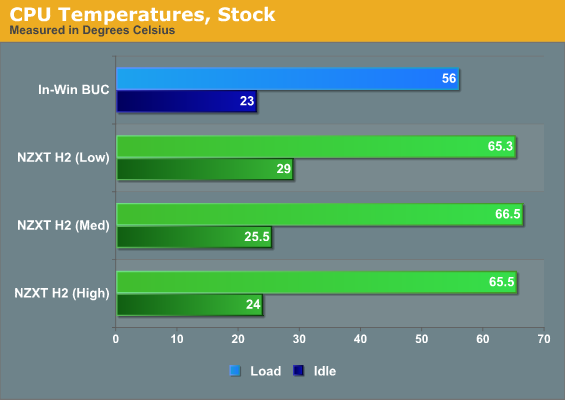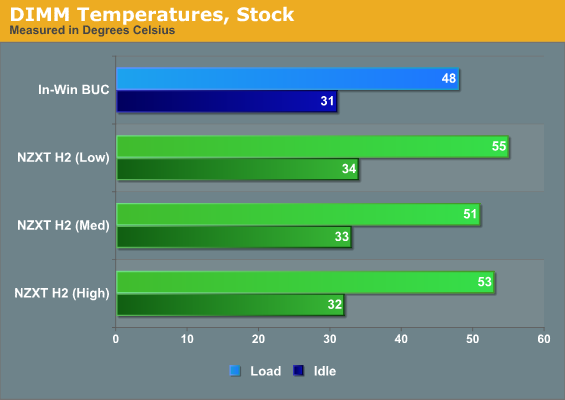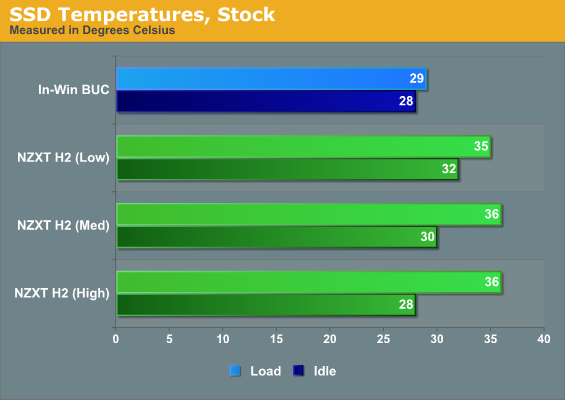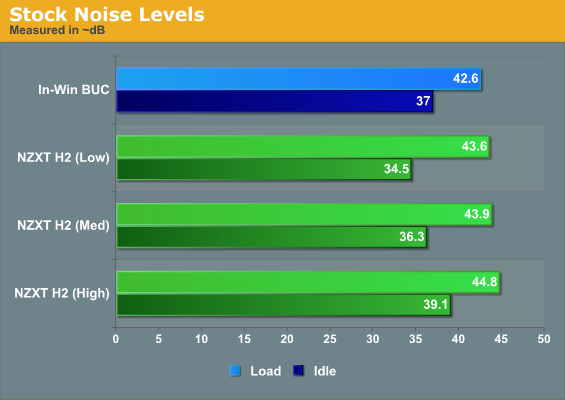NZXT H2: Not Quite Quiet
by Dustin Sklavos on May 26, 2011 2:43 AM EST- Posted in
- Cases/Cooling/PSUs
- mid-tower
- NZXT
Noise and Thermal Testing, Stock
Our stock settings for the testbed should provide a reasonable thermal load without causing too much work for the NZXT H2. Here we'll get to see both how well the sound-proofing works out, and if we have to make any sacrifices in performance for it. We tested with the fan controller at each setting.






Already we run into some problems with the H2, and it seems odd when it competes with the In-Win BUC which has virtually no sound-proofing installed at all. NZXT's design should operate like a well-refined positive pressure design, but if you check out other reviews online you're going to see many of the other reviewers ran into the same problem I did and placed the blame squarely in one place, a place where it really needs to be: the intake fans are suffocating.
Without a steady supply of fresh, cool air, everything inside the H2 has to work harder. So while the sound-dampening does its job fine while the system is idling, the instant you crank things up, the Zalman CNPS9900 on the processor and the GeForce GTX 580's fan both have to work double-time and virtually negate the quiet fans and sound-dampening of the H2.
You'll see that while idle temperatures consistently go down as you raise the fan speed, under load the H2 just can't cope with the heat and temperatures largely level off. You're better off leaving the case fans at the lowest setting. Meanwhile, the In-Win BUC proves just how much smart thermal management can do for noise levels.










19 Comments
View All Comments
SquattingDog - Thursday, May 26, 2011 - link
I was quite looking forward to seeing how this case faired, as the H1 Hush was decent and quiet overall. The H1 Hush looks like it may have had more intake capabilities, with around half of the front 120mm fan exposed.Perhaps this case would be ideal for standard builds, but just not cut out for the job of a high-performance gaming machine, given it's comparatively low airflow characteristics.
I agree that the asthetics are decent for the price-level, and the dampening foam and internal build quality definitely has an appeal...what a pity NZXT didn't sort out the intake capabilities...
sometaken - Thursday, May 26, 2011 - link
I assume anandtech will be testing more cases in the future. I would like to see how the Fractal Design Define R3 stacks up against this NZXT offering and vs. the P183. It is very similar in design and sells at the same price point of the NZXT. However it looks to offer better cooling yet still provide silent operation.EnzoFX - Thursday, May 26, 2011 - link
SPCR has a great review on the Define R3.Regarding the review, a noise floor of 32db is too damn high. I'll take your noise assessment seriously when you get under 16db.
JarredWalton - Thursday, May 26, 2011 - link
Under 16dB? Really? That would require a serious investment in testing equipment and facilities, because you're not going to get to that level otherwise. I have a somewhat better SPL meter compared to Dustin, and when my house is completely silent I've gotten measurements as low as 28dB. Even the slightest noise at that level (e.g. a bird chirping outside, a passing car or plane, etc.) will increase the level to 30-32dB.Regardless, all of the cases are measuring above 34dB in our tests, so while that might be slightly higher than you could measure with a different test location and better equipment, the scores are relative to each other and show a clear difference. If Dustin gets a case that doesn't register above the noise floor, then there's more to complain about.
hechacker1 - Thursday, May 26, 2011 - link
As an owner of the Fractal Design R3, I can say overall it's a nice case, especially for hard drive and cable management.It's touted as a silent pc, and indeed, it is much quieter than my former Lian Li case it replaced. However, it's not silent in the truest sense, it's clearly audible over background noise.
But then I have a gaming rig in it, so I don't expect it be to silent, just quiet, which it does really well.
I would like Anandtech to tackle the R3, and perhaps their newer Arch series, which looks like an slightly fixed version.
The only thing the R3 lacks is USB3.0, and more space behind the mobo tray.
jrs77 - Thursday, May 26, 2011 - link
If you want to build a silent PC, then there's no better cases around then the Define-series from Fractal Designs. They changed the dampening-material from bitumen to something foamy that doesn't smell anymore a while ago and their internal layout is clean and efficient.Having only two 5.1/4" bays in the R3 and Mini is very welcome in that regard.
doctormonroe - Thursday, May 26, 2011 - link
Hopefully this site will test this power supply and release a review of it in the not too distant future.kasseren - Thursday, May 26, 2011 - link
To me it looks like you'd be better of buying the Fractal Design Define R3 or if you want silence and design more the new Cooler Master Silencio 550 that both seem to be in the same price range.jasonnovak - Thursday, May 26, 2011 - link
I have this case and really like it. The last page of the SPCR review shows how to widen the slot on the bottom of the door for more air intake, though they didn't retest it. I haven't had any overheating issues on mild overclock i5-2500k but I think I may break out the dremel and give it a tryAffectionate-Bed-980 - Thursday, May 26, 2011 - link
If you're going to review a case every 2 years, then how do you compare data?How about comparing this to a P182 or P183 or a R3?